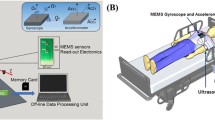Abstract
This paper presents a method to determine noninvasively relative pressures from magnetic resonance (MR) acceleration and velocity data. The technique is based on the complete Navier-Stokes equation associated with the direct measurement of the total acceleration, defined as the sum of the velocity derivative vs. time and the convective acceleration. It consists of determinining relative pressures by constructing a minimization problem of a quadratic energy function. The original ways of discretisation and computation allow to estimate relative pressures independently of a path of integration. The algorithm is applied to compute relative pressures over the diastolic filling of the left ventricle (LV) within a region of interest delineating the left atrium (LA) and the LV.
Access this chapter
Tax calculation will be finalised at checkout
Purchases are for personal use only
Preview
Unable to display preview. Download preview PDF.
Similar content being viewed by others
References
J. Bittoun, O. Jolivet, A. Herment, E. Itty, E. Durand, E. Mousseaux, and J.P. Tasu. Multidimensional mr mapping of mutiple components of velocity and acceleration by fourier phase encoding with a small number of encoding steps. Magn Reson Med, 44: 723–730, 2000.
M. Courtois, S. Kovács, and P. Ludbrook. Transmitral pressure-flow velocity relation. Circulation, 78: 661–671, 1988.
M. Firstenberg, P. Vandervoort, N. Greenberg, N. Smedira, P. McCarthy, M. Garcia, and J. Thomas. Noninvasive estimation of transmitral pressure drop across the normal mitral valve in humans: importance of convective and inertial forces during left ventricular filling. J Am Coll Cardiol, 36: 1942–49, 2000.
N. Greenberg, P. Vandervoort, M. Firstenberg, M. Garcia, and J. Thomas. Estimation of diastolic intraventricular pressure gradients by doppler m-mode echocardiography. Am J Physiol Heart Circ Physiol, 280: H2507–H2515, 2001.
D. Ling, J.S. Rankin, C.H. Edwards, P.A. McHale, and R.W. Anderson. Regional diastolic mechanics of the left ventricle in the conscious dog. Am J Physiol, 236: H323–H330, 1979.
J.P. Tasu, E. Mousseaux, A. Delouche, C. Oddou, O. Jolivet, and J. Bittoun. Estimation of pressure gradients in pulsatile flow from magnetic resonance acceleration measurement. Magn Reson Med, 44: 66–72, 2000.
J. Tyszka, D. Laidlaw, J. Asa, and J. Silverman. Three-dimensional, time-resolved (4d) relative pressure mapping using magnetic resonance imaging. JMRI, 12: 321–329, 2000.
S.N. Urchuk, E.F. Fremes, and D.B. Plewes. In vivo validation of mr pulse pressure measurement in an aortic flow model: preliminary results. Magn Reson Med, 38: 215–223, 1997.
S.N. Urchuk and D.B. Plewes. Mr measurement of time-dependent blood pressure variations. Magn Reson Med, 5: 621–627, 1995.
G.Z. Yang, P.J. Kilner, N.B. Wood, S.R. Underwood, and D.N. Firmin. Computation of flow pressure fields from magnetic resonance velocity mapping. Magn Reson Med, 36(4): 520–526, 1996.
Author information
Authors and Affiliations
Editor information
Editors and Affiliations
Rights and permissions
Copyright information
© 2003 Springer-Verlag Berlin Heidelberg
About this paper
Cite this paper
Balleux, F., Jolivet, O., De Cesare, A., Herment, A., Tasu, JP., Mousseaux, E. (2003). Estimation of the Diastolic Intraventricular Relative Pressures Using MRI Acceleration Measurements. In: Magnin, I.E., Montagnat, J., Clarysse, P., Nenonen, J., Katila, T. (eds) Functional Imaging and Modeling of the Heart. FIMH 2003. Lecture Notes in Computer Science, vol 2674. Springer, Berlin, Heidelberg. https://doi.org/10.1007/3-540-44883-7_27
Download citation
DOI: https://doi.org/10.1007/3-540-44883-7_27
Published:
Publisher Name: Springer, Berlin, Heidelberg
Print ISBN: 978-3-540-40262-6
Online ISBN: 978-3-540-44883-9
eBook Packages: Springer Book Archive




